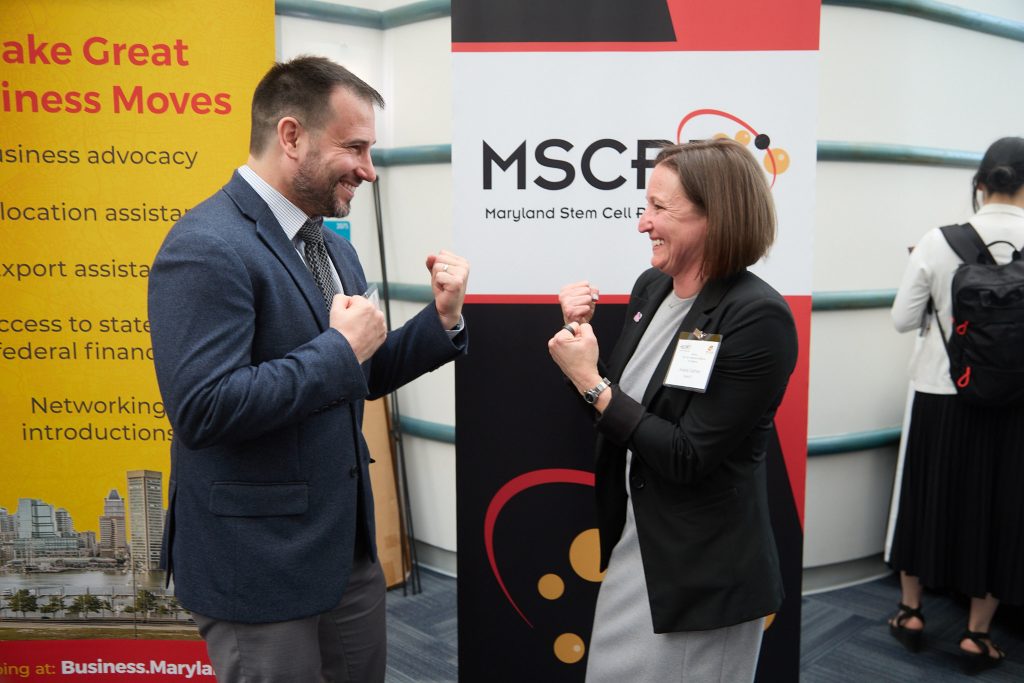Centralized vs. Point-of-Care Manufacturing
Insights from the 2025 MSCRF Showcase Debate
Centralized vs. Point-of-Care Manufacturing: What’s Next for Autologous Cell Therapies?
At the 2025 MSCRF Showcase Annual Conference, an Oxford-style debate brought two industry leaders to the stage to explore a question that is central to the future of regenerative medicine:
Which manufacturing model offers the greatest societal benefit for autologous cell therapies—centralized or point-of-care?
Representing both sides of this evolving landscape were:
- Dr. Jessica Carmen, Chief Commercial Officer at RoslinCT, advocating for centralized manufacturing, and
- Dr. Patrick Hanley, Chief and Director of the Cellular Therapy Program at Children’s National Hospital, making the case for point-of-care manufacturing.
While their perspectives diverged, both shared a mutual commitment to expanding access to safe, effective, and scalable therapies.

Opening Arguments: Setting the Stage
Dr. Jessica Carmen opened the debate by framing centralized manufacturing as the most efficient and safe model available today. She emphasized the importance of infrastructure efficiency, cost control, and regulatory oversight, arguing that manufacturing autologous therapies at scale across a few well-equipped facilities allows for better consistency, product testing, and cost amortization.
On the other side, Dr. Patrick Hanley presented a compelling case for point-of-care manufacturing, highlighting its potential to dramatically improve access and reduce turnaround time. He described first-hand challenges with the current centralized model, including delays in delivery, logistical complexity, and high treatment costs – pointing to international examples where localized models have succeeded in offering care at a fraction of the price.
Key Arguments: Scale vs. Speed, Cost vs. Access
Centralized Manufacturing:
- Efficiency and Cost Control: Centralized facilities spread high fixed costs—cleanrooms, labor, testing—across multiple batches, lowering cost per product.
- Standardization and Safety: Central manufacturing ensures consistency, especially critical given the inherent variability of autologous starting materials.
- Testing and Cryopreservation: Centralized models allow for full product testing before release and offer greater flexibility through frozen storage, enabling scheduled administration and backup dosing.
- Technology Considerations: Given that bioprocessing is still largely manual, she argued that it is not yet practical or cost-effective to implement GMP-compliant cleanroom environments at every hospital.
“Point-of-care manufacturing is likely associated with fresh product, which has biological advantages,” Carmen acknowledged, “but is not feasible without adequate technologies to support it and/or eliminate the need for a cleanroom”
Point-of-Care Manufacturing:
- Urgency and Access: With only ~20% of eligible patients receiving CAR-T therapies, decentralized manufacturing offers a faster, more accessible pathway—particularly for patients with rapidly progressing conditions.
- Logistical Efficiency: Onsite production avoids the delays and coordination challenges of centralized models, where high-value therapies are shipped offsite and returned days or weeks later.
- Proven Global Models: Programs such as Spain’s ARI-0001 and initiatives in India demonstrate that decentralized CAR-T manufacturing can be both safe and significantly more affordable, with costs as low as $27,000 per treatment.
- Regulatory Flexibility: One-patient-one-product therapies differ from traditional drugs and may benefit from tailored regulatory frameworks, as seen in emerging European models.
“We can do this safely,” Hanley argued, “and we are already seeing it done—both internationally and in academic institutions here in the U.S.”
Looking Ahead: Are We Choosing, or Combining?
Rather than framing the future of cell therapy as a choice between models, many believe the optimal solution may be a hybrid ecosystem:
- Centralized manufacturing could support scalable, standardized production for widely adopted therapies with predictable demand.
- Point-of-care models may serve urgent, niche, or geographically dispersed needs where centralized logistics introduce critical delays or added costs.
Much will depend on evolving technologies (like modular closed systems), regulatory flexibility, and investment in hospital-based infrastructure. But above all, the focus must remain on what’s best for patients – delivering life-changing therapies that are accessible, timely, and safe.
Final Takeaway
The 2025 MSCRF debate between Dr. Jessica Carmen and Dr. Patrick Hanley wasn’t just a clash of two models – it was a reflection of the real-world complexity of delivering advanced therapies.
Centralized manufacturing offers strength in standardization and scale. Point-of-care manufacturing offers speed, agility, and new opportunities for access.
The future may not demand that we choose one – but that we integrate both, thoughtfully and strategically, to unlock the full promise of autologous cell therapy for all patients.


